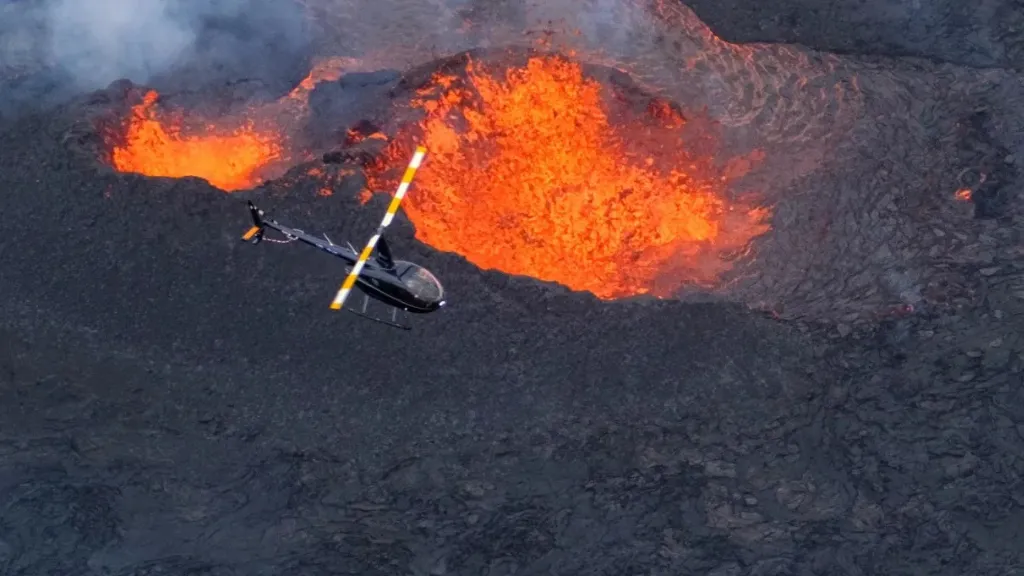Location: Sundhnúksgígar crater row on the Reykjanes Peninsula (north of Grindavík, southwest of Reykjavík)
Type: Fissure eruption
Start Time: Around 3:54–4:00 a.m. local time
Fissure Length: Approx. 700–1,000 meters
Nature: Effusive (lava flow, not explosive)

🔥 Current Impact
• Lava flowing southeast — no threat to Grindavík, major roads, or infrastructure.
• Blue Lagoon is open for public.
• Keflavík Airport, Reykjavík, and Ring Road remain fully operational.
• Volcanic gas and ash being monitored; Pele’s hair observed in some areas.
🧭 Safe Viewing Tour Recommendations
If you’re visiting or in Iceland and wish to view the eruption safely, consider the following:
1. Helicopter Tours
o Safe, bird’s-eye view of the lava fields and fissure.
o Operated from Reykjavík Domestic Airport or Grindavík heli base.
o Suitable for those wanting a dramatic but safe experience.
2. Guided Super Jeep or Hiking Tours
o Operated by licensed local guides with proper equipment.
o Keep a safe distance from the eruption site.
o These guides monitor wind, gas direction, and local updates continuously.
3. Volcano Viewpoints
o Authorities often establish marked safe zones on nearby hills.
o Accessible by foot or with small tour groups.
o Do not go alone or off-trail — volcanic glass, gas, and new fissures can be dangerous.
4. Evening or Night Tours
o Best for witnessing glowing lava.
o Be cautious of visibility, gas accumulation, and terrain in low light.
Always book with registered tour operators and follow local civil protection instructions.
📆 Updated Status in Coming Days
Authorities (Icelandic Meteorological Office and Civil Protection) are actively monitoring:
• Lava spread direction
• Seismic activity below the peninsula
• Gas emissions (especially sulphur dioxide and fine volcanic ash)
Expected in coming days:
• Lava may continue flowing for several more days, possibly forming small lava fields.
• If wind conditions change, Reykjavik and other towns may briefly experience gas odors or mild haze.
• Emergency services remain on alert, but no escalation is expected unless a new fissure opens closer to inhabited zones.
Daily reports are usually issued by the Icelandic Meteorological Office and Civil Defense. Local radio and emergency SMS alerts are active and accurate.
Volcano Safety Checklist for Travelers (Iceland – July 2025)
Whether you’re visiting Iceland or are already exploring near the eruption zone, follow this checklist to stay safe:
Before You Go
• Check Daily Updates from the Icelandic Meteorological Office or Civil Protection.
• Confirm with Tour Operator if your tour is still operating and safe.
• Dress Properly: Waterproof hiking boots, windproof/warm layers, gloves, and a hat.
• Pack Essentials:
o Water and snacks
o Flashlight/headlamp
o Sunglasses (for Pele’s hair)
o Mask or scarf (to reduce inhalation of sulphur gases)
o First aid kit
🧭 At the Site
• Stay in Designated Viewing Zones — Do not cross ropes or markers.
• Follow Your Guide’s Instructions at all times.
• Watch Your Step: Lava rock is sharp and unstable. Stay on paths.
• Stay Upwind of Gas — Move if you smell strong sulphur (like rotten eggs).
• Avoid Touching Lava or Pele’s Hair — Even if it looks cool, it’s extremely hot or razor-sharp.
🚫 What to Avoid
• Do not visit the eruption zone alone.
• Do not fly drones unless authorized — it’s illegal and disrupts rescue helicopters.
• Do not camp near active areas — even if the lava seems far away.
• Do not walk on fresh lava — crusts can collapse into molten lava underneath.
🚨 In Case of Emergency
• Call 112 for emergencies in Iceland (works via voice or SMS).
• Enable location sharing on your phone when near eruption zones.
• Keep power bank or spare battery for your phone/GPS.
✈️ General Travel Safety
• Double-check flight status before heading to the airport.
• If self-driving, check road closures at road.is and obey detour signs.
• Stay updated via local news, radio, or emergency text alerts.
🔥 Frequently Asked Questions
Is it safe to visit the eruption site?
Yes. The hike is guided by certified professionals and only takes you to officially designated safe viewing areas. Guides follow real-time updates from the Icelandic Meteorological Office and Civil Protection to ensure your safety at all times.
What is the difficulty level of the hike?
The hike is easy to moderate, suitable for travelers with average fitness. The terrain includes lava rocks and uneven ground, so sturdy hiking shoes are recommended.
Will we see active lava or an erupting crater?
You will see fresh lava fields, steaming vents, and possibly glowing lava from a distance, depending on activity and visibility. For close-up visuals of the crater, we recommend our optional helicopter upgrade.
What should I bring with me?
* Hiking boots
* Waterproof and windproof clothing
* Warm layers
* Hat, gloves, and sunglasses
* Water bottle and camera
We also recommend a face covering or scarf for protection against volcanic gas if needed.
Is the tour suitable for children?
Due to the volcanic environment and hiking conditions, we recommend this tour for children aged 10 and above.
Can I take photos and videos during the hike?
Absolutely! The eruption site offers stunning visuals. Your guide will also help you find the best angles for safe and memorable photos.
